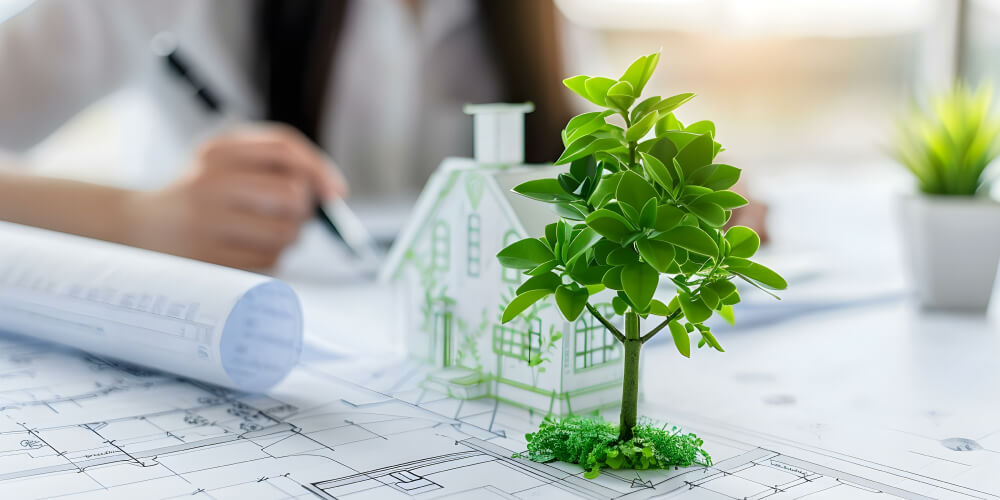1. LEED (Leadership in Energy and Environmental Design)
Overview:
- Developed by the U.S. Green Building Council (USGBC): LEED is one of the most widely recognized green building certification programs in the world.
- Comprehensive Standards: LEED covers a broad range of sustainability aspects, including energy efficiency, water conservation, materials selection, and indoor environmental quality.
Certification Levels:
- Certified: Basic level of certification for homes that meet the minimum requirements.
- Silver: Intermediate level for homes that exceed basic requirements and demonstrate a higher level of sustainability.
- Gold: Advanced level for homes with significant achievements in energy efficiency and sustainability.
- Platinum: The highest level, reserved for homes that achieve exceptional sustainability performance.
Benefits:
- Energy Savings: LEED-certified homes are designed to be energy-efficient, leading to lower utility bills.
- Healthier Living Environment: Improved indoor air quality and reduced exposure to toxins contribute to a healthier living space.
- Increased Property Value: LEED certification can enhance the market value of a home and attract environmentally conscious buyers.
2. ENERGY STAR
Overview:
- Developed by the U.S. Environmental Protection Agency (EPA): ENERGY STAR is a widely recognized certification for energy-efficient products and homes.
- Focus on Energy Efficiency: The program emphasizes reducing energy consumption and lowering greenhouse gas emissions.
Certification Criteria:
- Energy Efficiency: Homes must meet strict energy efficiency guidelines set by the EPA.
- Third-Party Verification: Independent inspections and testing ensure that homes meet the required standards.
Benefits:
- Lower Utility Bills: ENERGY STAR-certified homes use 15-30% less energy than typical new homes, resulting in significant cost savings.
- Environmental Impact: Reduced energy consumption translates to lower greenhouse gas emissions, contributing to environmental conservation.
- Enhanced Comfort: Improved insulation, windows, and HVAC systems lead to more consistent indoor temperatures and increased comfort.
Join HICP Homeowner’s Alliance
Connect with experts, get special discounts and enjoy member benefits
3. National Green Building Standard (NGBS)
Overview:
- Developed by the National Association of Home Builders (NAHB) and the International Code Council (ICC): NGBS provides a certification for residential buildings, including single-family homes, multi-family buildings, and remodels.
- Holistic Approach: The standard addresses various aspects of green building, including site design, resource efficiency, water conservation, and indoor air quality.
Certification Levels:
- Bronze: Entry-level certification for homes that meet the basic green building criteria.
- Silver: Intermediate level for homes that exceed the basic requirements.
- Gold: Advanced level for homes with significant achievements in sustainability.
- Emerald: The highest level, for homes that demonstrate exceptional performance in all areas of green building.
Benefits:
- Resource Efficiency: NGBS-certified homes use materials and resources more efficiently, reducing waste and environmental impact.
- Water Conservation: Improved water efficiency through the use of low-flow fixtures and sustainable landscaping practices.
- Health and Comfort: Enhanced indoor air quality and comfort due to better ventilation and reduced exposure to harmful chemicals.
4. Living Building Challenge
Overview:
- Developed by the International Living Future Institute: The Living Building Challenge is one of the most rigorous green building certification programs, focusing on regenerative design.
- Performance-Based: Certification is based on actual, rather than predicted, performance over a 12-month period.
Certification Criteria:
- Seven Petals: The program is organized into seven performance areas, known as Petals: Place, Water, Energy, Health and Happiness, Materials, Equity, and Beauty.
- Net Positive Energy: Homes must generate more energy than they consume.
- Net Positive Water: Homes must collect and treat all water on site.
Benefits:
- Regenerative Design: Living Building Challenge homes aim to have a positive impact on the environment, rather than just reducing harm.
- Holistic Sustainability: Comprehensive approach to sustainability, encompassing social equity and beauty, in addition to environmental performance.
- Health and Well-Being: Focus on creating healthy and inspiring living environments.
5. Passive House (PHIUS and Passivhaus)
Overview:
- Developed by the Passive House Institute (PHI) in Germany and the Passive House Institute US (PHIUS): Passive House certification focuses on energy efficiency and thermal comfort.
- Stringent Standards: The program emphasizes rigorous standards for energy consumption and airtightness.
Certification Criteria:
- Energy Efficiency: Homes must meet strict limits on heating and cooling demand, as well as primary energy consumption.
- Airtightness: Homes must achieve a high level of airtightness, verified through blower door testing.
- Thermal Comfort: Ensures consistent indoor temperatures and high levels of occupant comfort.
Benefits:
- Ultra-Low Energy Use: Passive House homes consume up to 90% less energy for heating and cooling compared to conventional homes.
- Exceptional Comfort: Superior insulation and airtightness create a draft-free, comfortable living environment.
- Resilience: High-performance building envelope enhances resilience to extreme weather and power outages.
6. WELL Building Standard
Overview:
- Developed by the International WELL Building Institute (IWBI): The WELL Building Standard focuses on enhancing health and well-being through building design and operation.
- Holistic Approach: Addresses various aspects of health, including air, water, nourishment, light, fitness, comfort, and mind.
Certification Criteria:
- Performance-Based: Certification is based on achieving performance metrics in each of the standard’s categories.
- Third-Party Verification: Independent testing and inspection ensure compliance with WELL standards.
Benefits:
- Health and Well-Being: Focus on creating environments that promote physical and mental health.
- Productivity: Enhanced indoor environments can improve productivity and well-being.
- Market Appeal: WELL-certified homes appeal to buyers interested in health-focused living spaces.
Green home certifications such as LEED, ENERGY STAR, NGBS, Living Building Challenge, Passive House, and WELL offer numerous benefits, from energy savings and environmental conservation to improved health and increased property value. By choosing certified green homes or pursuing certification for your home improvement projects, you can contribute to a more sustainable future while enjoying the advantages of a healthier, more efficient living environment. Embrace these certifications to ensure your home meets the highest standards of sustainability and performance.




















